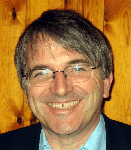
Three Questions for Neil Pakenham-Walsh
- Login to post comments
-

 CapacityPlus’s Rebecca Rhodes spoke with Neil Pakenham-Walsh, coordinator of the Healthcare Information For All by 2015 (HIFA2015) campaign and codirector of the Global Healthcare Information Network, at the recent HIFA2015 conference in London. The event focused on the how the HIFA2015 community of purpose is working toward addressing the information needs of health care providers in low-income countries. (Responses are excerpted from a longer interview.)
CapacityPlus’s Rebecca Rhodes spoke with Neil Pakenham-Walsh, coordinator of the Healthcare Information For All by 2015 (HIFA2015) campaign and codirector of the Global Healthcare Information Network, at the recent HIFA2015 conference in London. The event focused on the how the HIFA2015 community of purpose is working toward addressing the information needs of health care providers in low-income countries. (Responses are excerpted from a longer interview.)
Why is access to information important for health workers?
We use the term SEISMIC; it’s an acronym that stands for skill, equipment, information, structural support, medicines, incentives—including a decent salary, and communication facilities. If the health care provider has all of those needs except for up-to-date, reliable, relevant information, then the health care he will be providing is liable to be ineffective or harmful. Can you say something about translation? How do we make information accessible to people at a community level when they don’t have the same language?
Can you say something about translation? How do we make information accessible to people at a community level when they don’t have the same language?
That means that information not only needs to be in your own language but also in the right format […]. And if you are someone with no literacy then you may need to have most of your information presented either as voice, face-to-face, through theater, dance, or through pictures. One great thing about pictures, of course, is that they can be interpretable or understandable by people with many different languages.
This also makes me think about mobile phones because they are going to be available to pretty much everybody within a few years time either as something they own themselves or at least they know somebody who uses one [...]. We can expect [...] that you will be able to store massive amounts of data preloaded […] so it could provide a useful health educational material that shows you [a video of] what to do in an emergency. For example if someone gets a lump of meat stuck in their windpipe, then it could be life-saving to use the Heimlich maneuver.
And how do you see HIFA2015 contributing to accessible information?
Health care providers in low- and middle-income countries—especially if they are in remote and rural areas—they are working in a situation of information poverty. For example many people use notes that were taken in their training and they are still basing their practice on those notes 10 or 15 years later.
Now our strategy is such that we want first to bring together a critical mass of what we call global health care knowledge-system change agents. In other words these people [...] not only want to do their own jobs better but have a broader vision of improving availability of health care information generally. The second part of our strategy is to build a collective understanding of the various different information needs and ways of meeting these needs.
Related items:
Photo 1 by Jennifer Solomon. Photo 2 courtesy of Neil Pakenham-Walsh


